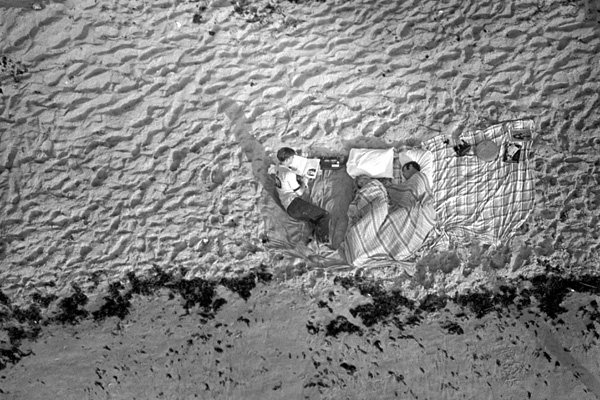Minha paisagem particular | My own private landscape
Simpatia é a pior coisa que alguém pode ter por uma performance. Mas é isso que se sente ao assistir You’ve changed, de Thomas Hauert. Quando estreou, no início de junho, no Festival Alkantara, em Lisboa, a performance mal poderia ser considerada finalizada, se levarmos em conta a profundidade de abordagens a que Hauert nos acostumou.
Ao propor a confluência de movimentos criados no espaço, por bailarinos que se comportam sem distinção de gênero e com outros projetados sobre uma tela entre o palco e a primeira fileira – repetindo com atraso os movimentos que acontecem no palco -, Hauert prolonga seu discurso conceitual sobre um corpo que precisa provar sua resistência no palco ao mostrá-lo em vez de pensá-lo.
É uma abordagem que se desliga da tendência comum e habitual da dança contemporânea, sugerindo um movimento que é mais cru, primitivo e acessível. É um movimento que expõe sua estrutura interna e, ao fazê-lo, expõe sua própria fragilidade e regride no que diz respeito à produção de uma imagem auto-explicativa e assim reflete sobre o espaço destinado a um movimento que existe por si só. Ao ser tão auto-consciente, Thomas Hauert se coloca em uma posição em que é o único responsável pela produção de sentido, deixando o espectador no papel invisível do destinatário.
Os bailarinos anonimamente produzem movimentos largos e esquemáticos, que aparentemente não têm relação com o que os outros fazem, exceto o risco de serem executados no mesmo espaço. A multiplicação de movimentos, pelo acúmulo de corpos no palco e do corpo na tela, não sugerem uma massa coletiva, como acontece em Accords, nem a relação com a música, como em Modify¸ ajuda no estabelecimento de uma construção em conjunto e em camadas.
Ao contrário, o que acontece em You´ve changed é uma exploração da crueza do movimento e, pela repetição (longe de propor um cânone), exaurindo o potencial metafórico do movimento.
Pode-se dizer que Hauert não está interessado em metáforas, isso não estaria longe da verdade, se levarmos em consideração que a singularidade do seu trabalho sempre esteve baseado na exibição da virtuosidade dos bailarinos, mas sem mostrá-los como inatingível. Por pertencer a uma geração que foi dominada por imagens e significados, as imagens que ele propõe são como paisagens coreográficas, onde os corpos existem mas não interferem. São passantes, não pertencem àqueles lugares. E por isso, não são veículos pelos quais pode-se perceber as intenções do coreógrafo. Sua frieza, crueza, sua fragilidade não ajudam a estrutura para se sustentar e, particularmente, não se protege de suas próprias fraquezas.
Portanto, quando uso o termo simpático, estou me referindo especificamente à falta de exploração do potencial coreográfico, percebido como a maneira como os bailarinos mergulham no potencial coreográfico. Pode-se entender, conceitualmente falando, que tais estruturas rochosas são atraentes para os bailarinos, mas me pergunto se deveríamos estar lá observando uma busca tão particular.
Being sympathetic is the worst thing one can be towards a performance. But this is the feeling one has when seeing You’ve changed, by Thomas Hauert. When it premiered in early June at Alkantara Festival, in Lisbon, the performance could hardly be completed, if we take into consideration the depth of the approaches Hauert’s used us to.
By proposing a confluence of movements created on space, by dancers who behave gender-anonymously, with others projected on a canvas between the stage and the stall – and those repeating with a delay the ones being showed on stage, Hauert prolongs his conceptual discourse on a body that has to prove it’s resistance on stage by showing it instead of thinking it.
It’s an approach that detaches itself from the common and regular trend of contemporary dance, suggesting a movement that is more raw, primitive and accessible. It’s a movement that exposes its inner structure and, by doing so, exposes its own fragility and sets itself back on what concerns the production of an image self-explanatory and thus reflects on the space given for a movement that exists on its own.
By being this self-conscient, Thomas Hauert puts himself in a place in which he is the sole responsible for the production of meaning, leaving the spectator on the invisible role of the receiver.
The dancers anonymously produce large and schematic movements which apparently have no relation with what the others do, except by the hazard of being done on the same space. The multiplication of movements, by the accumulation of bodies on stage and body on the screen do not suggest a collective mass, like it happened in Accords, nor the relation with the music , like in Modify, helps the establishment of an ensemble and layered construction.
Au contraire, what happens on You’ve changed is an exploitation of the rawness of the movement and, by the repetition (far from proposing a canon), exhausting the metaphorical potential of the movement.
One could say that Hauert is not interest in metaphors, and one would not be far from being right, if we take into consideration that the singularity of his work was always based on the exhibition of the virtuosity of the dancers, but not showing them as unreachable. Because he belongs to a generation that was overcome by images and meanings, the images he proposes are like chorographical landscapes, where the bodies exist but do not change it. They are passers by; they do not belong to those places. And by so, they are not vessels through which one could perceive the intentions of the choreographer. Its coldness, its rawness, its frailty do not help the structure to sustain itself and, particularly, does not protect itself from its own weaknesses.
Therefore, when using the term sympathetic, I’m referring specifically to the lack of exploitation of the cerographical potential, perceived from the way the dancers plunge themselves into the harsh structure. One can understand that conceptually speaking, such rocky structure is appealing to the dancers, but one wonders if we should be there seeing such private search.

